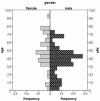Characteristics and risk factors for symptomatic Giardia lamblia infections in Germany
- PMID: 20105338
- PMCID: PMC2824735
- DOI: 10.1186/1471-2458-10-41
Characteristics and risk factors for symptomatic Giardia lamblia infections in Germany
Abstract
Background: In developed countries, giardiasis is considered a travel related disease. However, routine surveillance data from Germany indicate that >50% of infections were acquired indigenously. We studied the epidemiological characteristics of symptomatic Giardia infections acquired in Germany and abroad, and verified the proportion of cases acquired in Germany in order to investigate risk factors for sporadic autochthonous Giardia infections.
Methods: We identified Giardia cases notified by 41 local health authorities between February 2007 and January 2008 and interviewed them on their clinical symptoms, underlying morbidities, travel abroad and potential risk factors for the disease. We conducted a case-control-study including laboratory-confirmed (microscopy or antigen-test) autochthonous Giardia cases with clinical manifestations (diarrhoea, cramps, bloating) and randomly selected controls from the local population registry matched by county of residence and age-group (0-5, 6-19, > or =20 years). Secondary cases, controls with diarrhoea and persons who had travelled outside Germany in the three weeks prior to disease onset (exposure period) were excluded. We calculated adjusted odds ratios (aOR) with 95% confidence intervals (CI) using conditional logistic regression.
Results: Of 273 interviewed cases, 131 (48%) had not travelled abroad during the defined exposure period. Of these 131, 85 (65%) were male, 68 (54%) were living in communities with >100,000 inhabitants and 107 (83%) were aged 20 years or older. We included 120 cases and 240 controls in the case-control study. Cases were more likely to be male (aOR 2.5 CI 1.4-4.4), immunocompromised (aOR 15.3 CI 1.8-127) and daily consumers of green salad (aOR 2.9 CI 1.2-7.2). Contact with animals (pets/farm animals) and exposure to surface water (swimming/water sports) were not associated with symptomatic disease.
Conclusions: A substantial proportion of Giardia lamblia cases in Germany are indigenously acquired. Symptomatic cases are significantly more likely to be immunocompromised than control persons from the general population. Physicians should consider Giardia infections among patients with no recent history of travel abroad, particularly if they have immune deficiencies. Green salads may be an important vehicle of infection. Information campaigns highlighting this food-borne risk should emphasise the risk to persons with immune deficiencies.
Figures
Similar articles
-
Risk factors for sporadic Giardia infection in the USA: a case-control study in Colorado and Minnesota.Epidemiol Infect. 2018 Jul;146(9):1071-1078. doi: 10.1017/S0950268818001073. Epub 2018 May 9. Epidemiol Infect. 2018. PMID: 29739483 Free PMC article.
-
Immune response to Giardia lamblia in a water-borne outbreak of giardiasis in Sweden.J Med Microbiol. 1992 May;36(5):347-52. doi: 10.1099/00222615-36-5-347. J Med Microbiol. 1992. PMID: 1588586
-
Autochthonous and imported giardiasis cases: An analysis of two decades of national surveillance data, Germany, 2002 to 2021.Euro Surveill. 2024 May;29(20):2300509. doi: 10.2807/1560-7917.ES.2024.29.20.2300509. Euro Surveill. 2024. PMID: 38757286 Free PMC article.
-
Giardia duodenalis: the double-edged sword of immune responses in giardiasis.Exp Parasitol. 2010 Nov;126(3):292-7. doi: 10.1016/j.exppara.2010.06.014. Epub 2010 Jun 18. Exp Parasitol. 2010. PMID: 20599999 Free PMC article. Review.
-
Epidemiology of Giardia lamblia and Cryptosporidium infections in childhood.Isr J Med Sci. 1994 May-Jun;30(5-6):356-61. Isr J Med Sci. 1994. PMID: 8034482 Review.
Cited by
-
A descriptive analysis of notifiable gastrointestinal illness in the Northwest Territories, Canada, 1991-2008.BMJ Open. 2012 Jul 2;2(4):e000732. doi: 10.1136/bmjopen-2011-000732. Print 2012. BMJ Open. 2012. PMID: 22761280 Free PMC article.
-
Triage and protocol recommendations for the parasitology laboratory based on an epidemiological investigation of parasite diagnostics in Ontario laboratories.Can J Infect Dis Med Microbiol. 2014 Nov-Dec;25(6):305-10. doi: 10.1155/2014/452815. Can J Infect Dis Med Microbiol. 2014. PMID: 25587292 Free PMC article.
-
The controversies surrounding Giardia intestinalis assemblages A and B.Curr Res Parasitol Vector Borne Dis. 2021 Oct 19;1:100055. doi: 10.1016/j.crpvbd.2021.100055. eCollection 2021. Curr Res Parasitol Vector Borne Dis. 2021. PMID: 35284870 Free PMC article. Review.
-
A scoping review of risk factors and transmission routes associated with human giardiasis outbreaks in high-income settings.Curr Res Parasitol Vector Borne Dis. 2022 Feb 21;2:100084. doi: 10.1016/j.crpvbd.2022.100084. eCollection 2022. Curr Res Parasitol Vector Borne Dis. 2022. PMID: 36589877 Free PMC article.
-
Seasonality in human zoonotic enteric diseases: a systematic review.PLoS One. 2012;7(4):e31883. doi: 10.1371/journal.pone.0031883. Epub 2012 Apr 2. PLoS One. 2012. PMID: 22485127 Free PMC article.
References
Publication types
MeSH terms
LinkOut - more resources
Full Text Sources
Medical


